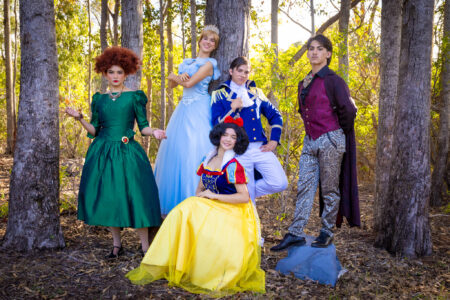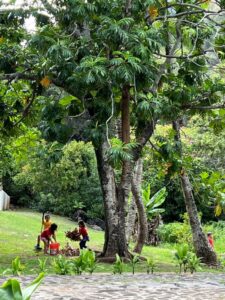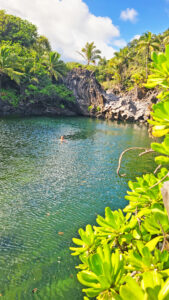Students approve as summer STEM program doubles in size
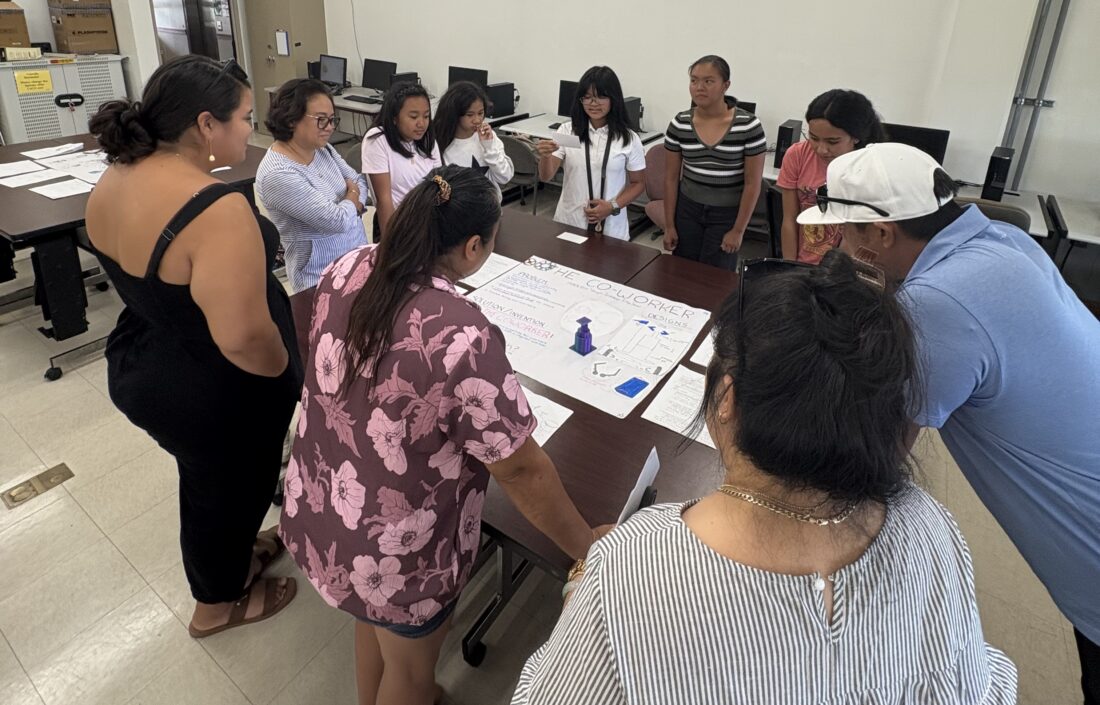
Students work as a group during a three-week summer program for middle school students teaching lessons in science, technology, engineering and math at the University of Hawaii Maui College. Courtesy photo
A three-week summer program that teaches middle school students lessons in science, technology, engineering and math — also known as STEM — was so popular that there were almost twice as many students, ideas and final projects this year as there were last year.
Tasked with addressing a community need for their final project, two students in the program decided to focus on helping farmers and created a device that uses electrodes to measure moisture levels and delivers water anytime the soil gets too dry.
To make it work, electrodes measuring moisture levels in the soil would send a message to a computer triggering a mechanical mechanism that rotated a straw bent into an elbow. With one end of the straw dipped in a cup of water, every time the straw turned, it would deliver a little dose of water to a cup of soil. The process would repeat until the soil had reached an acceptable moisture level.
“I’m glad that it’s working,” Savannah Fernandez said of her invention.
Savannah, who is going into the seventh grade, worked on the project for the Verizon Innovative Learning STEM Achievers Program with her partner, Lacy.
Together they used computer code to program the soil-watering system and engineering to fabricate their prototype, which they presented during the project showcase July 17 at the University of Hawaii Maui College.
“It’s really cool,” Savannah said of the program that allowed her and her partner the freedom to choose their own final project.
Savannah said she wasn’t terribly familiar with STEM technologies prior to joining the three-week program last year, and with two years of experience, she would definitely recommend it to any students who might be interested in the STEM fields.
The STEM Achievers summer program is hosted by Verizon in a partnership with the University of Hawaii Maui College. It all wrapped up last week with the final showcase of the students’ work. Through the program, students were paired with mentors — current college students and educators from similar backgrounds — to help them get engaged and excited about learning.
Based on her experience, Savannah said she wasn’t really sure if it felt more like learning or play.
“It kind of felt like both,” she said. “It felt like school that I was learning something, but it was fun at the same time.”
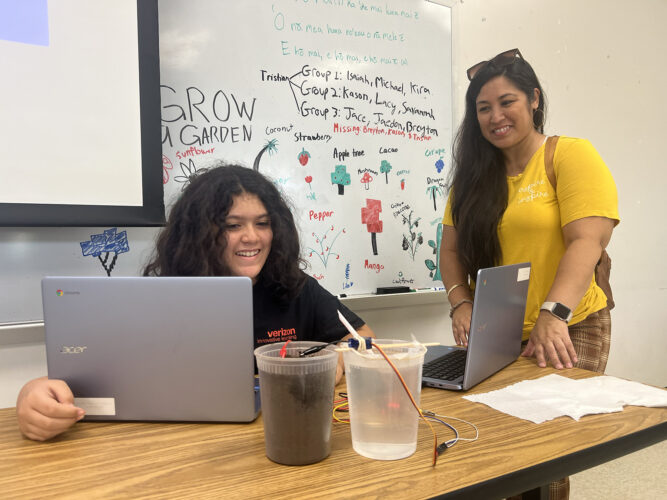
Dhana Fernandez smiles as her daughter Savannah explains a project Savannah did for the final week of the Verizon Innovative Learning STEM Achievers Program on July 17 at the University of Hawaii Maui College. The Maui News / Eli Pace
Her parents were also impressed with her work, and they too said they would recommend the program.
“She was in the program last year, and she just really seems to really like the robotics side, engineering, programming and computers — that’s her interest,” said Savannah’s mom, Dhana Fernandez.
“She’s good at math too,” added Savannah’s dad, Steven Fernandez.
In a different classroom at the college, a team of three girls used virtual reality technology to recreate historic places in Lahaina that were destroyed in the August 2023 wildfires.
Their idea was to take old photographs and videos to recreate places such as the historic Baldwin Home, and then use the VR representations to generate donations for the Lahaina Restoration Foundation.
“We can get donations by showing people what we lost and hope to get back,” one of the girls said during their presentation.
Along the way, they also learned a few lessons in history, according to Shana Cao, who was a part of the “AR-tists” three-girl team.
“It also makes our experience much more interactive, like we’re actually in the house, not just looking at it from a screen,” she said.
For Teri Evangelista, an associate professor of math at the college, it was impressive to see the girls build all of the individual items they had to recreate in VR for the Baldwin Home. It was also heartwarming to see so many projects focus on rebuilding Lahaina.
“It’s good to see that the kids aren’t just buried only in their own little world and just thinking about how things affect them, but to see them have a passion for where they came from and how we can move forward from something that should have never happened,” Evangelista said.
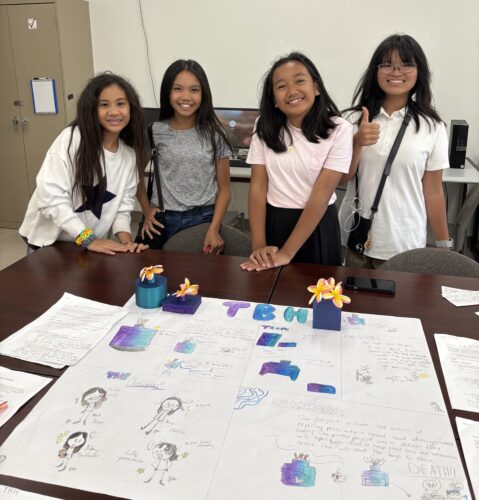
Students pose for a group photo during the Verizon Innovative Learning STEM Achievers Program. Courtesy photo
And the students’ ideas didn’t stop there.
Recognizing that many Maui County residents don’t have easy access to pharmacies, Ka’imi’ola Holi-Paet, who will be a seventh grader this fall, was part of a three-person team that came up with “Doctor Delivery,” a delivery service that brings medicine to the patients.
The idea started with a food delivery service and then shifted to medication, as Ka’imi’ola said they saw a need for people living in more remote parts of Maui County like Hana.
Ka’imi’ola said his group had to complete a worksheet on the five steps to inventing, and then they had to brainstorm ideas for how to solve a problem in the community.
After that, they had to learn how to code the microbits to control the rover and get their final project in motion. This was his second year with the program, and he also enjoyed it.
“I would say that this is new to me because I don’t really have access to any of these materials like 3D printing, rovers, microbits or any code,” Ka’imi’ola said. “So yes, it’s very fun … I would say I’ve learned a lot from the start of this program to this day.”

Students pose for a group photo during the Verizon Innovative Learning STEM Achievers Program. Courtesy photo
Last year was the first year for the three-week program that introduces students to rovers, microbits, 3D printing, virtual reality and more. This year, organizers doubled the number of classrooms and slots for students, and 150 middle school students were able to participate in it. Two weeks were spent rotating through various stations focusing on different pieces of STEM learning, and the students spent one week on their final projects.
“There’s so many cool things they can build with all these technologies,” said Sam Dameg, a computer science major at Oregon State University.
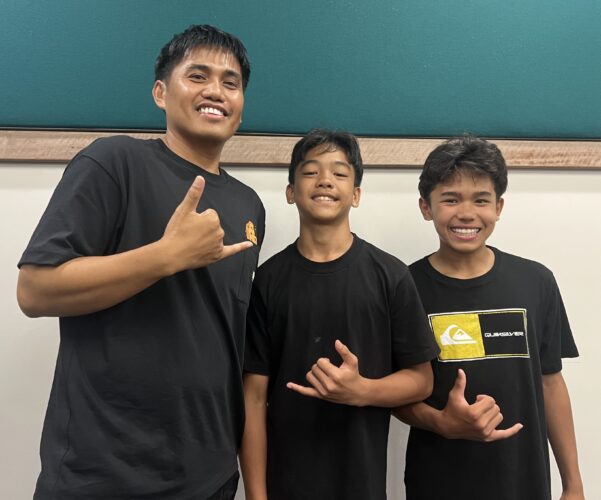
Sam Dameg, a student at Oregon State University, poses for a photo with two students while serving as a mentor for the Verizon Innovative Learning STEM Achievers Program on July 17 at the University of Hawaii Maui College. The Maui News / Eli Pace
Dameg is a huge proponent of the STEM program, and he came home for the summer to work as a mentor again this year after helping out last year. He’s already planning to come back next year.
“All the students are just hands-on,” he said with drones flying around the room behind him.
After posing with a couple students for a photo, Dameg said he enjoys telling them to “play with the technology” and “don’t be afraid of it.”
“They’re like, ‘But what if we break it?'” he said, adding that he tells them: “Don’t worry. We’ll fix it. That’s why it came with that extra stuff. We’re here to learn.”
Dameg said he encourages parents to get their children involved in STEM because it gives them exposure to technology they otherwise wouldn’t get to know and it has many applications in the world today.
“A lot of them don’t know what all this stuff is, and they can use this technology to help their communities and even to make money,” he said.



